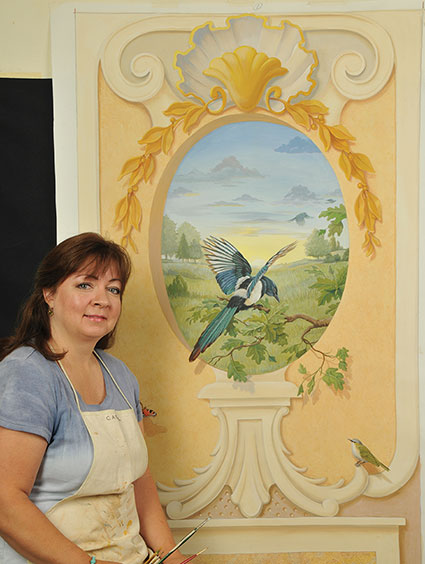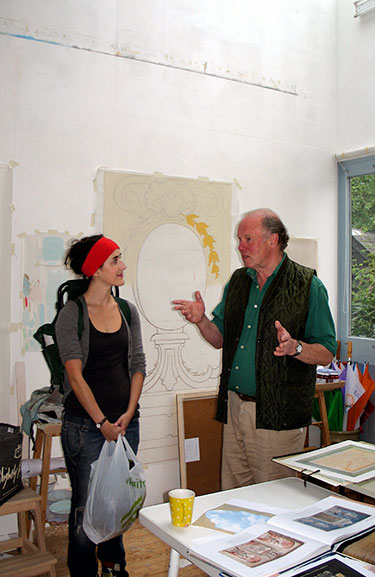Finishing Touches
Summer Painting Workshop
My latest decorative painting adventure took place this past July. Traveling to the countryside in Suffolk, England, I took a week-long trompe l’oeil painting workshop given by the world renowned muralist, Graham Rust. I have greatly admired this man’s artwork ever since his books were first published, like “The Painted House,” “Decorative Ornaments” and “The Painted Ceiling.” His successful career as an artist spans over five decades.
I first met Graham Rust at the 2004 Fauxcademy Convention in Las Vegas. His admirers flocked to his seminar to hear him speak about his art and career. I added my information to his mailing list at that time for possible future classes. The invitation to apply for his summer classes arrived in early spring of 2011. I knew immediately this was an opportunity not to be missed, and I was right in that assumption. I was notified of my acceptance within two weeks. This was the first year Graham and his partner, Rui Paes, offered classes in their private studio – a studio located behind “The Old Rectory,” the name of their historic home situated on ten acres in the tiny village of Somerton. The surrounding rural landscape was dominated by golden wheatfields, a few homes and an old stone church.
The English countryside is a place I’ve always wanted to visit – I love quaint places that have a sense of age and history (I was not disappointed). This workshop was a great reason to pack my bags and brushes, leave my family and just go off by myself to learn some new techniques. My accommodations were in the charming home of a friend of Rui. Angela Hudson-Evans offered up her home just for the artists traveling from abroad (apparently hotels are in Bury St. Edmunds, a distance of about 10 miles or so, but I didn’t want to rent a car in this foreign land). Her home is a cozy renovated country cottage with a beautiful flower and vegetable garden. She prepared delicious meals for us and also provided transportation to and from Graham’s house each day of the week. She was delightful company, and I know that I’ve made a new friend.

After several months of anticipation and lots of travel time, I excitedly arrived at the idyllic country estate. Graham himself opened the antique wooden door and said “Carol, welcome! Please come in.” I felt like I was walking into an enchanting dream. We stood for a bit in the reception room that had the outlines of future murals yet to be painted on the walls and ceilings. The mid-nineteenth century gothic home was tastefully decorated with fine antiques, fine art and murals – some that I recognized from his books.We gathered in the drawing room for introductions and such with the others. There were five other women taking the class. We drew numbers to fairly select our workstations in the studio. Luckily, my spot was next to the windows. The art studio has a high ceiling with a skylight, a small kitchen, a full bathroom, a loft area and a storage area and a large bookcase containing many reference books. The studio area is just big enough to accommodate seven workstations. Our 3’ x 6’ blank canvases were on the walls -- ready and waiting for us to create our masterpieces.
The task at hand began. Graham gave us the outlines of a decorative plasterwork frame with an oval opening in the center of the design. Each student had to come up with their own concept for the image to fill the oval opening. The reference books came in handy, and I found an illustration of a magpie bird that appealed to me, so I went with it. I found another cute, little bird to add to the panel and the background sky. Color sketches were made as well. As Graham said, “ It’s best to work out as much detail and color harmony as you can on paper before starting the finished piece. It will save you time in the long run.” There were a few original color sketches by Graham hanging in the studio, and I was amazed at the amount of tiny detail rendered. We were given Flashe paints by Lefranc & Bourgeois to work with on our panels. They react more like a gouache paint rather than acrylics – it took some time to get used to them. They tend to dry darker and a small amount can last a long time. White was added to every color mixture.
Initially, I didn’t know very much about Graham’s partner, Rui, but, he was charming, soft-spoken and easygoing. I was impressed to learn that he had illustrated the fifth children’s book written by Madonna called, “Lotsa de Casha.” The images are delightful, full of whimsy and detail, and I purchased a copy for my collection when I came home. I also have to say his critique of one’s work was spot on and most helpful. I recall one time he came up to me and said “That brown shadow on the shell looks horrid.” I said, “Horrid? Really?” “Yes, he said, “horrid! Stand back and take a look. It should be a cool gray tone like the rest of the shell. Put a wash over it and it will be fine.” I relented that he was correct and the effect became more subtle. The subtle nuances make a difference in trompe l’oeil painting. This was a lesson in refining one’s technique.
By the second day, most of us had started blocking in our murals in a semi-opaque, mid-tone groundcoat, covering all the raw sienna colored outlines. Washes of thin paint were used to add tone, texture and definition. Much attention was given to us by the master artists, and many helpful comments and advice were expressed to each student individually as they progressed. I worked swiftly and efficiently so that I could receive as much helpful advice as possible. I was the first to arrive each day so that I could have the peaceful art studio to myself for a short time. Everyone focused on their panels through most of the day, working from 10am until sometime past 6pm. Occasionally, the quiet in the studio was interrupted by the snorting sounds of one of Graham’s two french bulldogs or the three whippets looking for a snack.
We enjoyed having lunch all together in the formal dining room of the main house. It was decorated like a library with bookcases of old leather bound books. A skylight above the long table filled the room with natural light. The outlines of future murals were also painted on the walls – some trompe l’oeil of more books and some relief plaques. Lunch was expertly prepared by David, a framer, artist and friend of Graham who lives on the property. Teatime also was offered in the studio each day at 4pm with a homemade pastry. I was definitely feeling spoiled.

On the forth day of the workshop, Graham worked on a demonstration panel to show how he applies shading and highlights. It’s crucial to soften the edges of the shadows with a dampened flat brush to achieve a soft, natural look. We also realized it took a minimal amount of brushwork to achieve a maximum effect. Everyone made progress each day, but no one had enough time to complete their mural – that would be done at home. During a break I spoke with Graham about his travels, spending weeks and months at a time working onsite in the client’s home. He said, “These days I prefer to work on canvas murals in my studio. They can be shipped to the client and properly installed by an expert. After installation I can come in and do some touching up. It’s hard to leave the comfort of my home.” I don’t blame him for that.
On Friday, the last day of the workshop, we worked until 6pm as usual, then took a few pictures and said good-byes to each other and expressed our thanks to our most gracious hosts. I was a little sad to leave, but glad to have had the good fortune to make a lasting memory. Graham and Rui will offer more classes next summer.
About my background --- I’ve been a professional muralist and faux finisher since 2002. I graduated from Parsons School of Design in New York City in 1983 and worked in Manhattan for 17 years as a freelance illustrator/graphic designer. In 2005 I moved from New Jersey to Vero Beach, Florida and re-established my business, Artistic Brushworks. I took many decorative finishing workshops atThe Faux Effects® Studio in Vero Beach. In 2008 I traveled to Italy for a painting workshop in faux frescoes given by Nicola Vigini and Sean Crosby. Currently, I am accepting commission work for commercial or residential art projects. Samples of my work can be viewed on my website.

DECORATIVE ART BY: CAROL MAKRIS
PHOTOGRAPHY BY: CAROL MAKRIS
WRITTEN BY: CAROL MAKRIS
If you enjoyed this article, send
it to your friends on Facebook!





